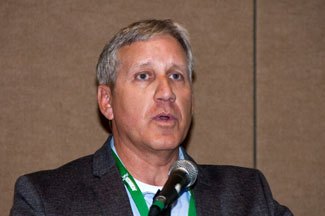Field Testing $B in Purebred Cattle
In field trial, high-$B group outperforms low-$B group in every metric.
by Troy Smith, field editor, Angus Media“There are skeptics out there. Not everyone is convinced, but EPDs (expected progeny differences) and selection indices work,” stated Tom Brink. “We can, at will, create high-value cattle.”

Tom Brink, CEO of the Red Angus Association of America (RAAA) and founder of Top Dollar Angus Inc.
Brink was referring to the power of modern genetic selection tools when he addressed attendees at the Beef Improvement Federation (BIF) Research Symposium and Convention hosted May 31-June 3 in Athens, Ga. The CEO of the Red Angus Association of America (RAAA) and founder of Top Dollar Angus Inc. spoke during the convention’s Advancements in End Product Improvement breakout session, saying broad use of the Angus beef dollar value index ($B) has resulted in production of better-feeding cattle, with better carcass merit, that generate more net profit to be shared across industry segments.
Brink discussed a field study conducted as “proof of concept” research. It compared high-$B Angus genetics to low-$B Angus in a typical production setting, while minimizing, as much as possible, environmental influences on the two genetic groups. He explained how the 43 purebred animals raised and harvested for this study were the result of embryo transfer. Both sides of their pedigrees were known and genetically quantified via American Angus Association EPDs and dollar value indexes ($Values). Fed together, at the same Kansas feedyard, the two $B groups were treated with a standard implant protocol and harvested in three drafts, targeting 0.50 inches in average backfat.
“The high-$Beef cattle out-performed low-$Beef animals in every metric evaluated,” reported Brink.
There was a pedigree average $B difference of $93.69 between the two groups ($141.12 vs. $47.40), which represented the expected difference in progeny of the research cattle. Since the study evaluated the animals themselves (not their progeny), the expected value difference between the high-$B and low-$B groups was twice their pedigree average $B difference, or $187.38 per head.
Brink called this dollar amount a reasonable prediction for how the cattle would perform. However, the study documented a real value difference of $215.47 per head, favoring the high-$B group.
“This shows that the predictive power of $B works extremely well in a real-world setting, and even is a little conservative,” stated Brink. “The take-home message? Use the tools. They work.”
Editor’s Note: This summary was written under contract or by staff of Angus Media. Through an agreement with the Beef Improvement Federation,
we are encouraging reprinting of the articles to those who will adhere
to the reprint guidelines available on this site. Please review those
guidelines or contact Shauna Rose Hermel,
editor, at 816-383-5270. PowerPoints are posted with permission of the
presenter and may not be reproduced in whole or in part without the
express permission of the presenter.
Angus Media’s coverage of the event is made possible through
collaboration with BIF. For questions about this site, or to notify us
of broken links, click here. Look for additional coverage in the Angus Journal, the Angus Beef Bulletin, the Angus Journal Daily, the Angus Beef Bulletin EXTRA and Angus TV.


